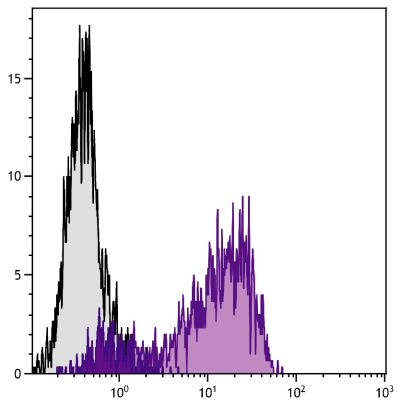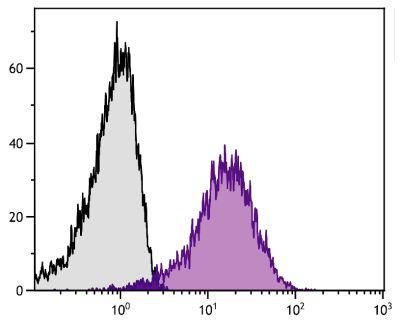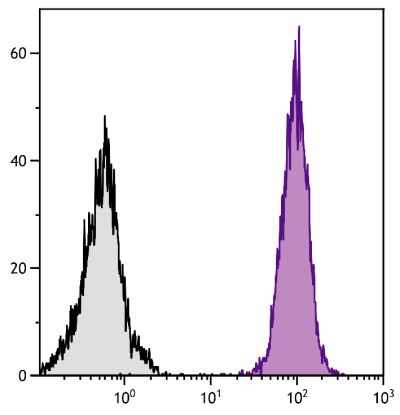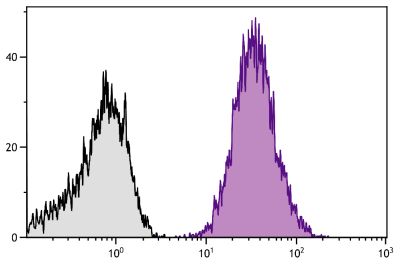Mouse Anti-Human CD14-SPRD (61D3)
Cat. No.:
9561-13
PE/CY5 (SPRD) Anti-Human CD14 antibody for use in flow cytometry assays.
$255.00
| Clone | 61D3 |
|---|---|
| Isotype | Mouse (BALB/c) IgG1κ |
| Isotype Control | Mouse IgG1-SPRD (15H6) |
| Specificity | Human/Cynomolgus/Canine/Hooded Seal CD14 |
| Alternative Names | LPS-R, LPS receptor, gp55 |
| Description | CD14 is a 55 kDa glycosphosphatidylinositol (GPI)-anchored single chain glycoprotein. It is expressed on monocytes, macrophages, dendritic cells, and Langerhans cells. It is also weakly expressed on neutrophils. CD14 appears to be involved in clearance of gram-negative bacteria via its high affinity binding to LPS-LPB complexes. |
| Immunogen | Human peripheral monocytes |
| Conjugate | SPRD (R-phycoerythrin/Cyanine 5) |
| Buffer Formulation | Phosphate buffered saline containing < 0.1% sodium azide and a stabilizer |
| Clonality | Monoclonal |
| Concentration | Lot specific |
| Volume | 1.0 mL |
| Recommended Storage | 2-8°C; Avoid exposure to light; Do not freeze |
| Trademark Information |
Spectral Red® is a registered trademark of Southern Biotechnology Associates, Inc. Spectral Red® is a PE/CY5 tandem conjugate Cy® is a registered trademark of Global Life Sciences Solutions Germany GmbH |
| Applications |
Flow Cytometry – Quality tested 3,6-8 Immunohistochemistry-Frozen Sections – Reported in literature 4 Immunocytochemistry – Reported in literature 3,5 Western Blot – Reported in literature 3 ELISA – Reported in literature 3 Cytoxicity – Reported in literature 1 Blocking – Reported in literature 2,3 Separation – Reported in literature 9 |
| RRID Number | AB_2796939 |
| Gene ID |
929 (Human) 102129342 (Cynomolgus) 607076 (Canine) |
| Gene ID Symbol |
CD14 (Human) CD14 (Cynomolgus) CD14 (Canine) |
| UniProt ID |
P08571 (Human |
| UniProt Name |
CD14_HUMAN (Human) |
Documentation
Certificate of Analysis Lookup
Enter the Catalog Number and Lot Number for the Certificate of Analysis you wish to view
- 1. Ugolini V, Nunez G, Smith RG, Stastny P, Capra JD. Initial characterization of monoclonal antibodies against human monocytes. Proc Natl Acad Sci USA. 1980;77:6764-8. (Immunogen, Cyto)
- 2. Flora PK, Gregory CD. Recognition of apoptotic cells by human macrophages: inhibition by a monocyte/macrophage-specific monoclonal antibody. Eur J Immunol. 1994;24:2625-32. (Block)
- 3. Devitt A, Moffatt OD, Raykundalia C, Capra JD, Simmons DL, Gregory CD. Human CD14 mediates recognition and phagocytosis of apoptotic cells. Nature. 1998;392:505-9. (Block, WB, FC, ELISA, ICC)
- 4. Beckstead JH, Wood GS, Fletcher V. Evidence for the origin of Kaposi's sarcoma from lymphatic endothelium. Am J Pathol. 1985;119:294-300. (IHC-FS)
- 5. Larsen AK, Nymo IH, Boysen P, Tryland M, Godfroid J. Entry and elimination of marine mammal Brucella spp. by hooded seal (Cystophora cristata) alveolar macrophages in vitro. PLoS One. 2013;8(7):e70186. (ICC, Hooded Seal Reactivity)
- 6. Pilling D, Vakil V, Gomer RH. Improved serum-free culture conditions for the differentiation of human and murine fibrocytes. J Immunol Methods. 2009;351:62-70. (FC)
- 7. Carter AS, Cerundolo L, Koo DD, Rust NA, Morris PJ, Fuggle SV. Cross-species reactivity of a panel of antibodies with monkey and porcine tissue. Xenotransplantation. 1999;6:123-30. (FC, Cynomolgus Reactivity)
- 8. de Amorim IF, da Silva SM, Figueiredo MM, Moura EP, de Castro RS, de Souza Lima TK, et al. Toll receptors type-2 and CR3 expression of canine monocytes and its correlation with immunohistochemistry and xenodiagnosis in visceral leishmaniasis. PLoS One. 2011;6(11):e27679. (FC, Canine Reactivity)
- 9. Lindsey JW, Hatfield LM. Epstein-Barr virus and multiple sclerosis: cellular immune response and cross-reactivity. J Neuroimmunol. 2010;229:238-42. (Sep)
See All References







